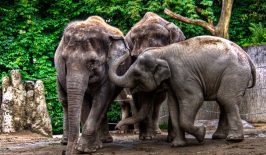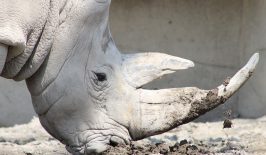The cheetah is the rarest big cat in Africa. The last viable populations of these cats live in Southern Africa throughout Namibia and Botswana, but their numbers are low: around just 3,000 individuals.
Despite what we’ve all seen in documentaries, very few cheetahs actually live in the African savanna. In southern Africa, the cheetah is best adapted to farmland, where there is less competition from big predators like lions, leopards and hyenas.
When researchers from the Leibniz Institute for Zoo and Wildlife Research (IZW) began collaring cheetahs, they discovered something unexpected about how this unique big cat communicates. The research is now helping to save cheetahs, cattle and farmers’ livelihoods.
“It is so special … it’s so different from all the other cats in so many ways,” says Dr. Jörg Melzheimer of the IZW, who has been researching cheetahs for over a decade.
The cheetah is famed for its lightning speed, and indeed this evolutionary adaptation is absolutely essential for the species’ survival – the lithe cheetah simply can not bring down bulky prey the way that muscular lions and leopards can. It can’t outpower its rivals, but it can certainly outrun them.
Because of its smaller size, cheetahs opt for smaller prey: younger animals, or leaner antelopes like springbok or hartebeest. Unfortunately, this proclivity for small prey means that cattle calves are a staple on many cheetahs’ menus.
As a result, many cattle farmers in Namibia were experiencing high losses. They were losing a lot of calves – and a lot of money.
“Many of them [the farmers] tried to solve the problem in a lethal way,” explains Melzheimer. “If we don’t manage to preserve the cheetah there on the farmlands, together with the farmers, then we will not preserve them. And this was actually our starting point for the project.”
Melzheimer emphasises that shooting cheetahs is not something most farmers take lightly. Sometimes, however, their hand is forced.
“I always ask the audience: who of you is willing to take €20,000 to sustain a species, even an endangered species … to support this? Out of your own pocket?”
For the researchers, building trust with the farmers was key – though it was by no means easy. “For the first three years, we were listening,” says Melzheimer. “I think we established a really nice cooperation and collaboration with them.”
“Not only the first, but the three first cheetahs I saw were killed by farmers,” explains Melzheimer. “Obviously it was tough. I really like these animals, I don’t like to see them dead. But I didn’t make a fuss, you know. I tried to understand the situation.”
High-resolution GPS Collars
As part of efforts to better understand the movements of cheetahs in the area, the IZW project fitted over 300 cheetahs with high-resolution GPS collars. With these collars, the researchers received a data point every 15 minutes. This detailed data gave them unprecedented insight into the everyday lives of cheetahs.
“We have a smaller aircraft, so we tag every cheetah every 4 weeks. The collar has a radio ping, so we can locate the animal and then we fly closeby,” Melzheimer explains. “We need to be less than 500 metres close to the cheetah and then we have a very energy-efficient data upload. Basically like wi-fi.”
After years of gathering data, the scientists noted something strange. The cheetahs seemed to be moving in what looked like networks. Over and over again, different cheetahs traversed similar paths to reach the same set of destinations.
“It actually looks like a net on the landscape,” says Melzheimer. “These nodes where all these animals meet, and then lines between these nodes.”
The researchers deduced that these hubs were key to how cheetahs – who often roam solitarily – communicate with one another over long distances.
“These communication hubs are the centres, the areas where males and females meet,” says Melzheimer. “I’m always saying it’s like the fancy bar in the town.”
When a female cheetah is in the area and is interested in a local male, she will mark the location – typically a tree, termite mound or a rock – with urine. When a male arrives, he’ll know the female is in the area. He will then hear her calling at night, and they’ll meet at the predetermined “hub”.
Fascinatingly, these hubs can remain stable over generations of cheetahs.
This new insight, in addition to being a critical step forward in understanding cheetah behaviour, turned out to be crucial for the cattle farmers too.
Melzheimer tells the story of one farmer who lost an average of 30 calves per year. The IZW team suggested moving the cattle herd out of the cheetahs’ communication hub area to see if the farmer would still lose so many calves.
The farmer was sceptical at first. “He said: yeah, I mean we can try, but look, I’m telling you: the cheetahs are there because of my calves, so the cheetahs will clearly follow the herd,” explains Melzheimer.
But, incredibly, it worked. When the farmer moved his calves, his losses fell to almost zero.
“We were able to reduce losses by 86%,” says Melzheimer. Melzheimer believes that even without a lot of investment from the project managers, a farmer can easily reduce their losses by 70 per cent when equipped with knowledge about the cheetahs’ communication hubs.
“Our role in the community really changed from being a beggar to being an advisor,” says Melzheimer. “Within weeks, the farmers called us!”
The case is a shining example of how human-wildlife conflicts can be managed in a way that also respects conservation efforts – while also increasing knowledge about a unique and rare species.
Already, Melzheimer’s team has started to branch out and upscale their work. “We started something similar now with the leopards, so let’s see where this ends.”









